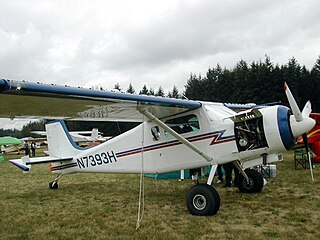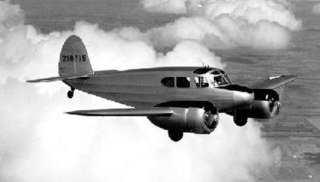
The Piper PA-28 Cherokee is a family of two-seat or four-seat light aircraft built by Piper Aircraft and designed for flight training, air taxi and personal use. The PA-28 family of aircraft comprises all-metal, unpressurized, single piston-engined airplanes with low-mounted wings and tricycle landing gear. They have a single door on the right side, which is entered by stepping on the wing.

The Tupolev Tu-134 is a twin-engined, narrow-body jet airliner built in the Soviet Union for short and medium-haul routes from 1966 to 1989. The original version featured a glazed-nose design and, like certain other Russian airliners, it can operate from unpaved airfields.

The de Havilland Canada DHC-1 Chipmunk is a tandem, two-seat, single-engined primary trainer aircraft designed and developed by Canadian aircraft manufacturer de Havilland Canada. It was developed shortly after the Second World War and sold in large numbers during the immediate post-war years, being typically employed as a replacement for the de Havilland Tiger Moth biplane.

The Canadair CT-114 Tutor is a jet trainer that was designed and produced by Canadian aircraft manufacturer Canadair. It served as the standard jet trainer of the Royal Canadian Air Force (RCAF), and later Canadian Armed Forces, between the early 1960s and 2000.

The Beechcraft Travel Air was a twin-engine development of the Beechcraft Bonanza. It was designed to fill the gap between the single engine Model 35 Bonanza and the much larger Model 50 Twin Bonanza, and ultimately served as the basis for its replacement, the Baron.

The Murphy Moose is a Canadian high-wing utility light aircraft produced in kit form by the Chinese-owned Murphy Aircraft of Chilliwack, British Columbia for amateur construction. The Moose can be purchased as a "quick-build" kit which comes partly pre-assembled.

The Piper PA-34 Seneca is a twin-engined light aircraft, produced in the United States by Piper Aircraft. It has been in non-continuous production since 1971. The Seneca is primarily used for personal and business flying.

The Piper PA-44 Seminole is an American twin-engined light aircraft manufactured by Piper Aircraft.

The Beechcraft Model 76 Duchess is an American twin-engined monoplane built by Beechcraft intended partly as a low cost introduction to twin-engine aircraft.

The Beechcraft Musketeer is a family of single-engined, low-wing, light aircraft that was produced by Beechcraft. The line includes the Model 19 Musketeer Sport, the Model 23 Musketeer, Custom and Sundowner, the Model 23-24 Musketeer Super III the retractable gear Model 24-R Sierra and the military CT-134 Musketeer.

The Cessna AT-17 Bobcat or Cessna Crane is a twin-engine advanced trainer aircraft designed and made in the United States, and used during World War II to bridge the gap between single-engine trainers and larger multi-engine combat aircraft. The commercial version was the Model T-50, from which the military versions were developed.

The Pacific Aerospace Corporation CT/4 Airtrainer series is an all-metal-construction, single-engine, two-place with side-by-side seating, fully aerobatic, piston-engined, basic training aircraft manufactured in Hamilton, New Zealand.

The Beechcraft Model 77 Skipper is a two-seat, fixed tricycle gear general aviation airplane, originally designed for flight training but also used for touring and personal flying.

The Grumman American AA-5 series is a family of American all-metal, four-seat, light aircraft used for touring and training. The line includes the original American Aviation AA-5 Traveler, the Grumman American AA-5 Traveler, AA-5A Cheetah, and AA-5B Tiger, the Gulfstream American AA-5A Cheetah and AA-5B Tiger, the American General AG-5B Tiger, and the Tiger Aircraft AG-5B Tiger.

The Slingsby T67 Firefly, originally produced as the Fournier RF-6, is a two-seat aerobatic training aircraft, built by Slingsby Aviation in Kirkbymoorside, Yorkshire, England.

The Grob G 120 is a two-seat training and aerobatic low-wing aircraft with a carbon composite airframe, built by Grob Aircraft. It is based on the Grob G 115TA training aircraft and is specially designed for military and civil pilots training. It has a tricycle landing gear and a low tailplane.

3 Canadian Forces Flying Training School is located at the Southport Aerospace Centre just south of Portage la Prairie, Manitoba, Canada.

The Beechcraft AT-10 Wichita was an American World War II trainer built for the United States Army Air Forces (USAAF) by Beechcraft. It was used to train pilots for multi-engined aircraft such as bombers.

The AS/SA 202 Bravo is a two to three-seat civil light aircraft jointly designed and manufactured by the Swiss company Flug- und Fahrzeugwerke Altenrhein (FFA) and the Italian company Savoia-Marchetti. The aircraft was designated the AS 202 in Switzerland, and the SA 202 in Italy.

The Gazuit-Valladeau GV-103 Gazelle was a French-built light two- to four-seat training, aerobatic and touring aircraft of the late 1960s.





















